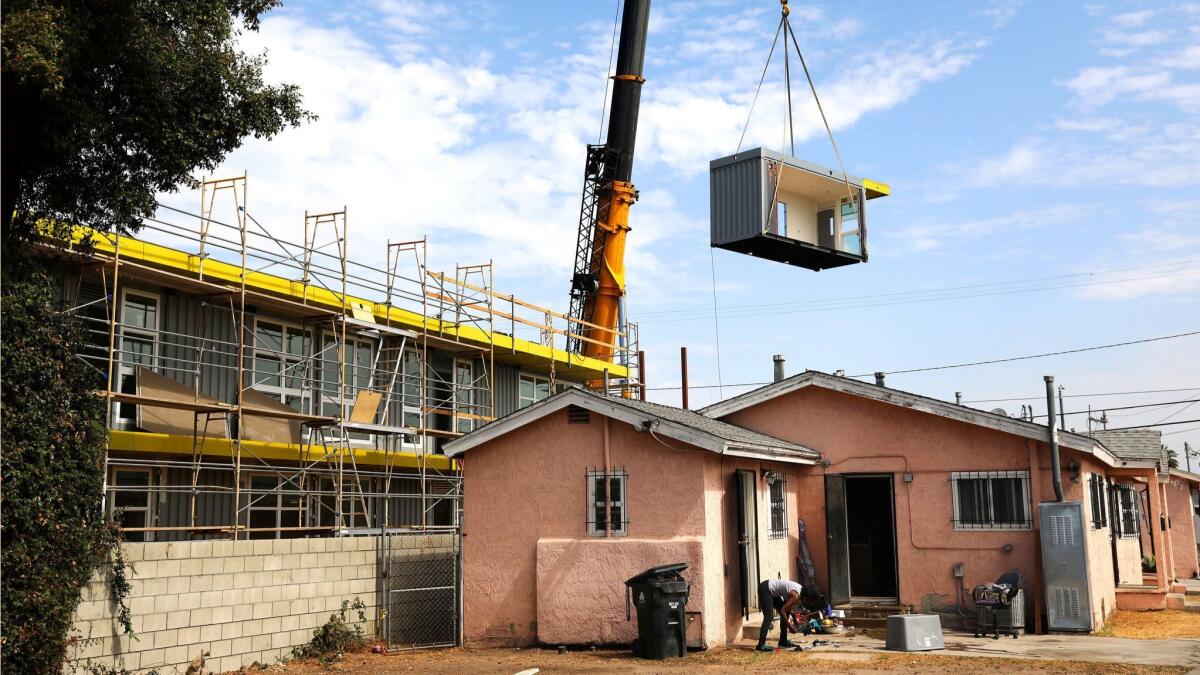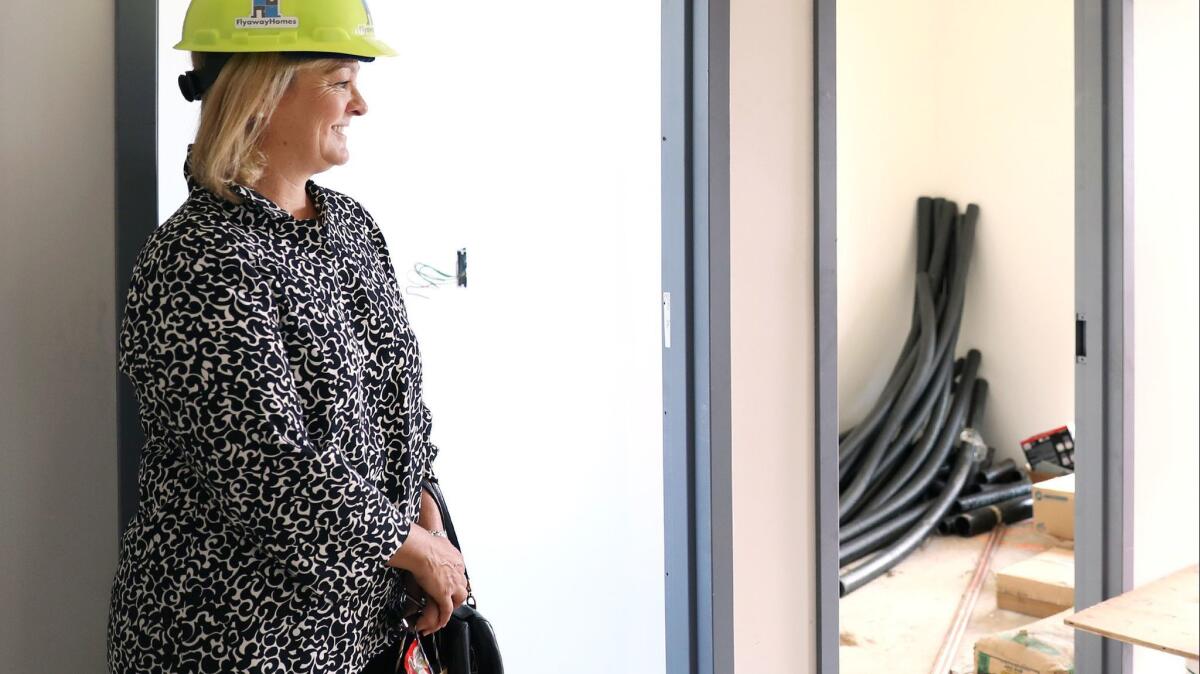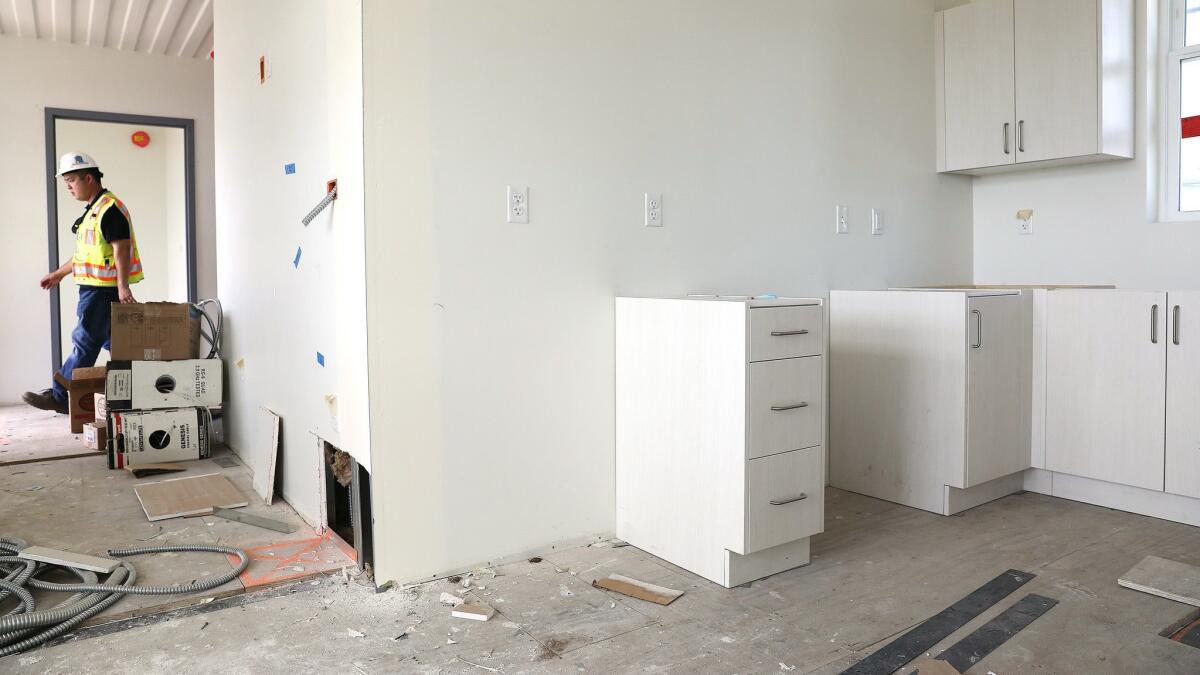Developer tests a new way to fund housing for the homeless: private financing

- Share via
Sometime this fall, 32 homeless people will move into a supportive housing project now rising on Colden Avenue, a transitional street of apartments and aging houses in South Los Angeles.
Soon after that, another group of people who are not homeless, and in fact quite well off, will also begin receiving benefits from the nine-unit apartment building. Fifty-six equity holders who financed the project will begin to see their first returns, expected to be about 5% annually.
The $3.6-million housing project, built from shipping containers, is an experiment in using private investment to create homeless housing. Its backers, led by a family-owned Westside real estate investment company, hope to replicate it to produce thousands of units financed entirely by people willing to accept a modest return on money invested in a socially beneficial purpose.
After its completion, the building will function much like the permanent supportive housing that is being constructed with subsidies from the city’s $1.2-billion Proposition HHH bond.
It will have a long-term commitment to lease to the chronically homeless.
Tenants will be selected through the coordinated entry system, a countywide database of homeless people that gives the highest priority to those most in need.
As with other supportive housing, tenants will cover their rent either with disability checks or subsidies, and services for them will be funded with L.A. County’s Measure H homeless sales tax, or charitable donations.
But unlike the nonprofit organizations that build the bulk of affordable and homeless housing, FlyawayHomes, the profit-making venture behind the project, will use no taxpayer funds for construction.
The project is an outgrowth of the permanent supportive housing task force of the People Concern, a West Los Angeles homeless services nonprofit.
After Proposition HHH passed in 2016, the group — whose members came from academia, banking and development — concluded that even if the city achieved its goal of producing 10,000 units of supportive housing in a decade, many of its estimated 31,000 homeless people would remain without housing.
They decided to focus on market solutions that wouldn’t require HHH funds.
“There are a lot of organizations doing good projects with those,” said Lawry Meister, president and CEO of the Steaven Jones Development Co., founded by her father. “We want to fill another void. We want to help make a dent in the bigger problem.”

Members of the task force formed FlyawayHomes with Jones, an 18-year board member of the People Concern, as chairman and Meister as president. Though Flyaway is a for-profit company, it is run as a social benefit organization. Its officers, all task force members, receive no pay. All revenues above the investors’ returns will be turned back into more housing, Meister said.
Its mission is to house people faster and for less than the prevailing nonprofit model, which provides a single unit for every tenant and gets its financing through a cumbersome process, cobbling HHH funds with tax credits and other public funds.
Those projects usually take three or more years to build, and they now cost an average of more than $450,000 per unit.
By relying on private investment, Flyaway can avoid some of the requirements that contribute to those costs, such as paying a prevailing wage.
And by limiting its search to sites where it has the right to build, Meister hopes to avoid the cost of holding land during long entitlement proceedings and community engagement.
For the Colden project, the company made one presentation to the neighborhood council, where it met no opposition. Residents watching the construction recently said they saw the project as an improvement to the neighborhood.
The search for suitable land — another obstacle that slows down supportive housing projects — fell to Flyaway Chief Operating Officer Kevin Hirai, whose family-owned business manages hundreds of residential units. He found the solution in his own portfolio, an aging duplex with a willing seller on a lot zoned for multifamily use. The tenants agreed to move into other units Hirai managed.
To manage costs, FlyawayHomes adopted an unusual housing format with eight four-bedroom units for 32 tenants. Each will have a private bedroom, but share kitchen and living spaces with three others. A manager will live in the ninth unit.
The project’s cost of $400,000 per unit is within the range of other supportive housing, but at $109,000 per tenant, four times as many people will get homes.
For speed, Flyaway turned to modular housing.
It contracted with GrowthPoint Structures, a Los Angeles company that manufacturers such buildings from recycled shipping containers, in May 2017.
GrowthPoint, which was opening a new factory to keep up with increasing demand, couldn’t deliver on schedule, causing a delay of nearly a year.
But once the first units arrived in June, construction moved swiftly. Each floor of the three-story building was placed in a day, the final one by mid-July. Finish work will take another month or two.
Flyaway’s strategy is to build with bank financing, then lease the buildings to an agency such as the People Concern to generate a steady cash flow. That agency, in turn, would find the subsidized tenants, collect the rent and provide the services. Equity in the project could then be bought and sold by social impact investors with a guaranteed, though modest, return.
But to prove the concept, they needed to come up with the $3.6 million.
To raise it, they turned to friends and clients and people associated with the People Concern.
“We were blown away by how receptive they were to the concept,” Meister said. “We were able to raise that amount of money in six weeks.”

Among the donors, Tina Quinn, a friend of Meister’s since childhood and until recently chair at UCLA’s Institute of Environmental Sustainability, had no hesitation when Meister called.
Quinn said she and her husband cared deeply, but hadn’t yet done anything about homelessness.
“We weren’t sure about how to help,” she said. “The proof of concept is important to us, to try innovative ways to address homelessness.”
Gary W. Hampar, the trustee of a charitable foundation that invests in downtown shelters, said he wouldn’t have been interested as a strict investment, but “the bottom line is there was a decent return and you’re doing something for society.”
Retired lawyer Michael Lawler said he had invested with the Steaven Jones company in a Marina del Rey project and trusted Jones and Meister to deliver.
Once the rent of about $278,000 starts flowing, investors will receive a 4.5% return off the top and then split 75% of the net cash flow. Meister estimates it will work out to about 5% annually.
With the Colden project still under construction, FlyawayHomes has opened escrow on another property near 88th Street and Vermont Avenue.
The model has evolved for the second project. This time, one investor will provide the land and part of the construction cost through a 1031 exchange, a real estate swap that avoids taxes. Foundation and corporate money will make up the rest.
“We’re just in the process of setting it up now,” Meister said. “Get our investor list. We’re just beginning to approach people.”
How far Flyaway’s for-profit model can go will depend both on its success in tapping institutional investors and on the People Concern’s capacity to supply tenants with subsidies.
In the Colden project, 13 of the tenants will pay their own $550 rent through their Social Security disability, but 20 of the bedrooms are being funded at about $800 per unit by the county’s Housing for Health project, which pays subsidies with a limited supply of county money.
But as long as apartments for homeless people remain hard to find, as they are today, there’s probably a lot of room to grow.
“We’re working with the People Concern to figure out what is our goal,” Meister said. “Ideally, we would house 20,000 people.”
Twitter: @LATDoug
UPDATES:
1:20 p.m.: This article was updated with additional details about the program.
This article was originally published at 10:10 a.m.
More to Read
Sign up for Essential California
The most important California stories and recommendations in your inbox every morning.
You may occasionally receive promotional content from the Los Angeles Times.











